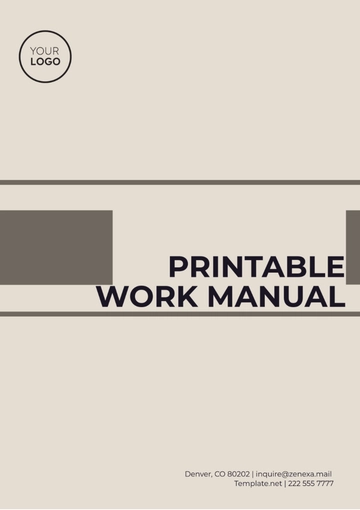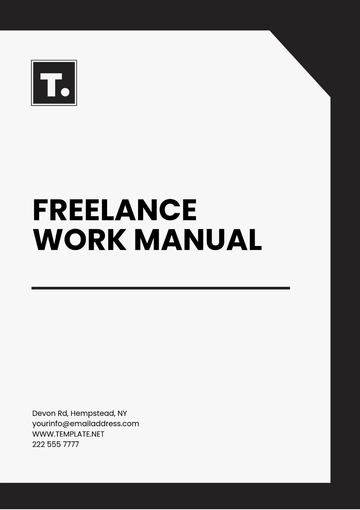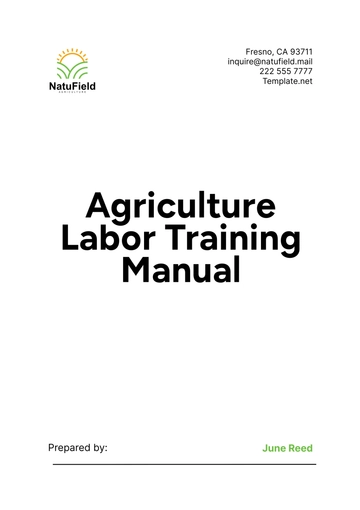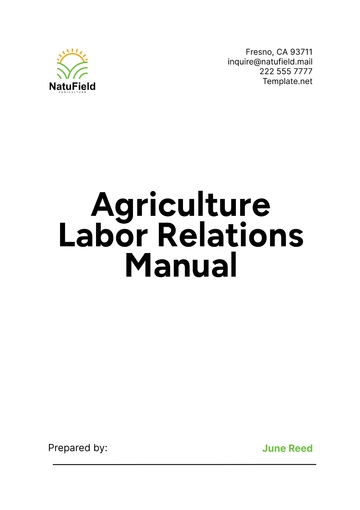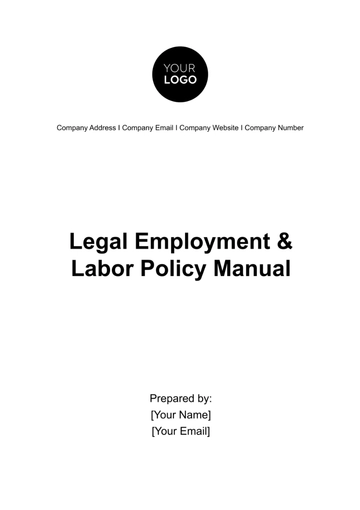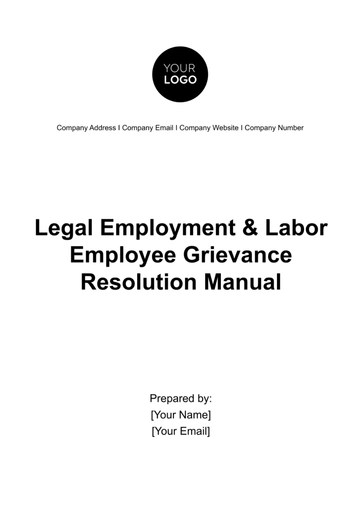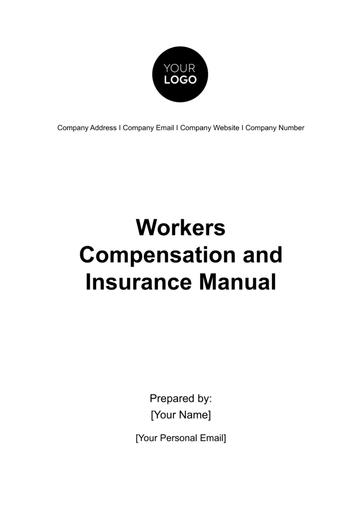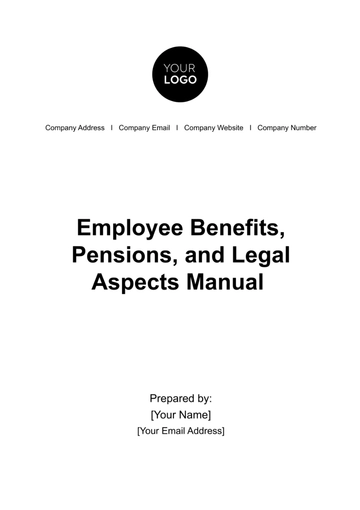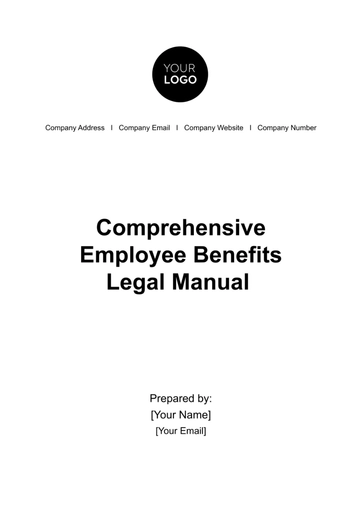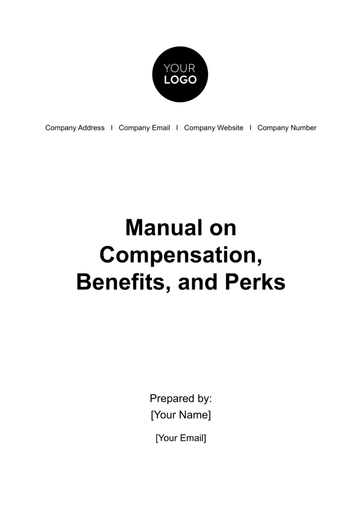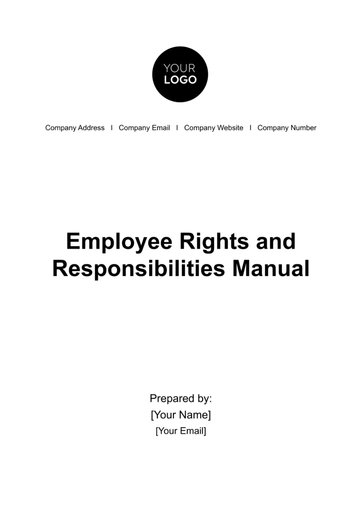Free Legal Employment & Labor Employee Grievance Resolution Manual

I. Introduction
A. Overview
This manual serves as a comprehensive guide for our employees to navigate through the Grievance Resolution process. It is designed to provide clear and detailed instructions on how to address and resolve workplace grievances effectively. The manual is a testament to our commitment to maintaining a harmonious and respectful work environment.
In addition, the manual emphasizes the importance of open communication and fairness in handling employee concerns. It provides a structured approach to resolving grievances, ensuring consistency and transparency in the process. This approach is crucial in fostering trust and respect among employees, thereby contributing to a positive work environment.
B. Purpose
Transparency: The primary purpose of this manual is to provide a clear, systematic, and transparent process for addressing and resolving employee grievances. This manual serves as a roadmap for employees, guiding them through the steps they need to take when they encounter issues in the workplace.
Fair Treatment: Another key purpose of this manual is to ensure that all employees, regardless of their position or tenure, are treated fairly and equitably. It aims to foster a culture of respect and dignity where every employee’s rights are upheld.
Reference for Employees: Lastly, this manual serves as a reference for employees to understand their rights, responsibilities, and the procedures involved in the grievance resolution process. It empowers employees by providing them with the knowledge and tools they need to effectively navigate and participate in the grievance resolution process.
C. Scope
Universal Applicability: This manual applies to all employees of the company, regardless of their position, tenure, or department. It ensures that every employee, from entry-level to senior management, has access to the grievance resolution process. This universal applicability ensures that all employees are aware of their rights and the company’s commitment to upholding these rights.
Types of Grievances: The manual covers all types of grievances that an employee might encounter in the workplace. This includes, but is not limited to, issues related to discrimination, harassment, bullying, pay and benefits, and working conditions. By covering a wide range of potential issues, the manual ensures that employees have a clear understanding of what constitutes a grievance and how to address it.
D. Importance
Addressing employee grievances in a timely and fair manner is crucial for maintaining a positive work environment. It helps to build trust and respect among employees, which in turn contributes to higher productivity and employee satisfaction.
Furthermore, the grievance resolution process also ensures that the company complies with labor laws and regulations. By providing a clear and systematic process for resolving grievances, the company demonstrates its commitment to upholding the rights and welfare of its employees. This commitment is integral to the company’s mission and values, and is reflected in every aspect of its operations.
II. Understanding Employee Grievance
An employee grievance refers to a formal complaint that has been raised by an employee towards an employer within the workplace. It can cover any issues, acts, or situations that the employee believes infringe on their rights or hinder their work.
The following table provides a brief overview of the different types of employee grievances that can occur in the workplace:
Types | Description |
|---|---|
Discrimination | If the employee feels they are being treated unfairly due to race, color, religion, sex, or national origin. |
Harassment | Acts or behavior that create a hostile work environment. |
Bullying | Continuous unfair treatment by a colleague or superior. |
Pay And Benefits | Disputes regarding salary, raises, benefits, and other forms of compensation. |
Working Conditions | Conditions of the workplace that are believed to be inappropriate or unsafe. |
Understanding the different types of grievances is crucial in ensuring a fair and effective grievance resolution process. Each type of grievance has its own unique characteristics and challenges, and therefore requires a tailored approach for resolution. The following provides a detailed breakdown of each type of grievance, along with the procedures for resolving them:
A. Discrimination
Definition: Discrimination refers to unfair treatment based on an individual’s race, color, religion, sex, or national origin. It is a serious violation of an individual’s rights and is strictly prohibited by law.
Impact: Discrimination can have a significant impact on an individual’s work experience and overall well-being. It can lead to a hostile work environment, lower job satisfaction, and reduced productivity.
Resolution: Resolving discrimination grievances requires a thorough investigation into the allegations, followed by appropriate corrective actions if the allegations are found to be true. This could involve disciplinary action against the perpetrator, changes to company policies, or diversity and inclusion training for employees.
Prevention: Preventing discrimination in the workplace is a key responsibility of the employer. This involves creating a culture of respect and equality, providing regular training on diversity and inclusion, and implementing strict anti-discrimination policies.
B. Harassment
Definition: Harassment refers to any unwelcome behavior that creates a hostile work environment. It can include offensive jokes, slurs, name-calling, physical assaults, threats, intimidation, ridicule, insults, offensive pictures, and more.
Impact: Harassment can have a profound impact on an individual’s mental and physical health, as well as their ability to perform their job effectively. It can lead to stress, anxiety, depression, and lower job satisfaction and productivity.
Resolution: Resolving harassment grievances involves identifying the source of the harassment, taking immediate action to stop the behavior, and implementing measures to prevent future occurrences. This could involve disciplinary action against the perpetrator, changes to company policies, or harassment prevention training for employees.
Prevention: Preventing harassment in the workplace is a key responsibility of the employer. This involves creating a respectful and inclusive work environment, providing regular training on harassment prevention, and implementing strict anti-harassment policies.
C. Bullying
Definition: Bullying refers to repeated, unwanted, aggressive behavior that involves a real or perceived power imbalance. It can include threats, spreading rumors, attacking someone physically or verbally, and excluding someone from a group on purpose.
Impact: Bullying can have a significant impact on an individual’s mental and physical health, as well as their ability to perform their job effectively. It can lead to stress, anxiety, depression, and lower job satisfaction and productivity.
Resolution: Addressing bullying grievances requires a comprehensive approach that includes raising awareness about bullying, encouraging reporting, investigating allegations, and enforcing disciplinary measures against perpetrators.
Prevention: Preventing bullying in the workplace is a key responsibility of the employer. This involves creating a respectful and inclusive work environment, providing regular training on bullying prevention, and implementing strict anti-bullying policies.
D. Pay and Benefits
Definition: Disputes regarding pay and benefits refer to any disagreements or dissatisfaction an employee might have with their salary, raises, benefits, or other forms of compensation. These could arise due to perceived inequities, errors, or unfulfilled promises.
Impact: Such disputes can significantly affect an employee’s motivation, job satisfaction, and financial stability. They can also lead to a sense of injustice and lower morale in the workplace.
Resolution: Resolving these grievances involves a thorough review of the employee’s compensation package, benchmarking it against industry standards, and ensuring it complies with all legal requirements. If discrepancies are found, corrective measures such as adjusting the pay or benefits should be taken.
Prevention: To prevent such grievances, employers should maintain transparency in their compensation policies, regularly review and update their pay scales, and ensure equitable distribution of raises and benefits.
E. Working Conditions
Definition: Grievances related to working conditions involve situations where the conditions of the workplace are believed to be inappropriate or unsafe. This could include issues related to the physical work environment, work hours, resources, or the behavior of colleagues.
Impact: Poor working conditions can lead to physical and mental health issues, decreased productivity, and low job satisfaction. They can also increase the risk of accidents in the workplace.
Resolution: Resolving these grievances requires a thorough assessment of the working conditions, identification of the issues, and implementation of corrective measures. This could involve improving the physical work environment, adjusting work hours, providing necessary resources, or addressing behavioral issues.
Prevention: Employers can prevent such grievances by maintaining a safe and healthy work environment, providing adequate resources, and promoting respectful behavior in the workplace.
By addressing grievances in a timely and fair manner, the company can prevent issues from escalating and negatively affecting the workplace environment. This contributes to higher employee satisfaction, lower turnover, and improved productivity. Therefore, it is in the best interest of both the company and its employees to effectively address and resolve grievances. Remember, your voice matters, and we are here to listen and help. We believe that by working together, we can resolve any issues that arise and continue to create a positive and productive workplace for everyone.
III. Reporting a Grievance
A. Recognizing a Grievance
Identifying a Grievance: It is important for employees to recognize when they have a grievance. This could be when they feel they are being treated unfairly, are subjected to a hostile work environment, or believe their rights are being violated. Recognizing a grievance is the first step towards its resolution. It allows the employee to take control of the situation and seek the necessary help and support.
Documenting the Grievance: Once an employee identifies a grievance, they should document all relevant details. This includes the nature of the grievance, the parties involved, any witnesses, and any attempts made to resolve the issue. Documenting the grievance is crucial as it provides a record of the incident, which can be useful during the resolution process.
Seeking Advice: If an employee is unsure whether their issue constitutes a grievance, they should seek advice from a trusted colleague, supervisor, or human resources representative. Seeking advice can provide the employee with a different perspective on the situation and can help them decide on the best course of action.
Deciding to Report: After considering all the facts and advice, the employee needs to decide whether to report the grievance. This decision should be based on the severity of the issue, its impact on the employee’s work, and the likelihood of resolution. The decision to report a grievance is a significant one, as it sets the resolution process in motion.
B. Reporting Process
Initial Report: If an employee decides to report a grievance, they should do so to the Human Resources (HR) department immediately. The report should be in writing and include all relevant details. The initial report is the first official step in the grievance resolution process. It brings the issue to the attention of the HR department, who are responsible for handling such matters.
HR Acknowledgement: Upon receiving the report, the HR department will acknowledge receipt and provide an overview of the next steps in the grievance resolution process. This acknowledgement reassures the employee that their grievance has been received and will be addressed.
Confidentiality: All reports of grievances are treated with confidentiality to protect the rights and privacy of all parties involved. Confidentiality is crucial in maintaining trust in the grievance resolution process.
Non-Retaliation: The company has a strict non-retaliation policy. Any employee who reports a grievance will not be subjected to any form of retaliation. This policy ensures that employees feel safe to report grievances without fear of negative consequences.
IV. Investigating a Grievance
A. Initiation of Investigation
Receipt of Grievance Report: Upon receipt of a grievance report, the HR team will initiate an investigation. The purpose of the investigation is to gather all relevant facts and evidence related to the grievance. The investigation is a crucial part of the grievance resolution process as it provides the basis for the resolution.
Appointment of Investigator: The HR team will appoint an investigator who is impartial and has no personal interest in the outcome of the investigation. The investigator plays a key role in the grievance resolution process. They are responsible for conducting a thorough and unbiased investigation into the grievance.
Investigation Plan: The investigator will develop a plan for the investigation. This includes identifying what information needs to be gathered, who needs to be interviewed, and what documents need to be reviewed. The investigation plan provides a roadmap for the investigation, ensuring that all relevant aspects of the grievance are explored.
Notification to Involved Parties: The HR team will notify all parties involved in the grievance about the investigation. This includes the employee who filed the grievance, the person(s) against whom the grievance was filed, and any potential witnesses. Notifying all parties ensures that everyone is aware of the investigation and has the opportunity to provide their side of the story.
Time Frame: The investigation will be conducted in a timely manner. The exact time frame will depend on the complexity of the grievance and the availability of all parties involved. Conducting the investigation promptly helps to resolve the grievance in a timely manner, which is beneficial for all parties involved.
B. Conducting the Investigation
Review of Initial Complaint: The investigator will start by reviewing the initial complaint to understand the nature of the grievance and the parties involved. This review provides the investigator with a clear understanding of the grievance, which is crucial for conducting a thorough investigation.
Analysis of Relevant Information: The investigator will analyze any relevant information, documents, or policies related to the grievance. This analysis helps the investigator to understand the context of the grievance and to identify any potential violations of company policies or laws.
Interviews: The investigator will conduct interviews with the person who filed the grievance, any witnesses, and any other relevant personnel. These interviews provide the investigator with first-hand accounts of the incident, which are crucial for understanding the grievance from different perspectives.
Fact-Finding: The investigator will gather all facts related to the grievance. This may involve reviewing documents, emails, or other forms of evidence. Fact-finding is a crucial part of the investigation as it provides the investigator with the evidence needed to make a fair and informed decision.
Investigation Report: After all facts have been gathered, the investigator will produce an investigation report. This report will summarize the findings of the investigation and provide recommendations for resolution. The investigation report is a crucial document as it provides a record of the investigation and forms the basis for the resolution of the grievance.
C. Post-Investigation
Review of Investigation Report: The HR team will review the investigation report and determine the appropriate resolution based on the findings. This review ensures that the resolution is fair and is based on the evidence gathered during the investigation.
Communication of Resolution: The HR team will communicate the resolution to all parties involved. This includes the employee who filed the grievance and the person(s) against whom the grievance was filed. Communicating the resolution ensures that all parties are aware of the outcome of the investigation and the steps that will be taken to resolve the grievance.
Implementation of Resolution: The HR team will implement the resolution. This could involve disciplinary action, policy changes, or other measures to address the grievance. Implementing the resolution is a crucial step in resolving the grievance and preventing similar issues in the future.
Follow-Up: The HR team will follow up with all parties involved to ensure that the resolution has been implemented and the grievance has been addressed. Follow-up is crucial for ensuring that the resolution is effective and that the issue has been resolved to the satisfaction of all parties.
Documentation: The HR team will document all steps of the investigation and resolution process. This documentation will be kept confidential and stored in accordance with company policy and legal requirements. Documentation is crucial for maintaining a record of the grievance and its resolution.
V. Appealing a Resolution
A. Understanding the Appeal Process
Right to Appeal: Every employee who has raised a grievance and is not satisfied with the proposed resolution has the right to appeal. This right is fundamental to ensuring that employees feel heard and that their concerns are fully addressed. It provides an additional layer of scrutiny to the grievance resolution process, ensuring that no stone is left unturned in the pursuit of a fair and just resolution.
Grounds for Appeal: The grounds for an appeal can be varied and depend on the specifics of the grievance and the resolution proposed. It could be that the employee perceives an error in the investigation process, has new evidence that was not considered in the initial investigation, or believes that the resolution proposed does not adequately address the grievance. Identifying the grounds for appeal is the first step in the appeal process and sets the direction for the appeal.
Appeal Procedure: The appeal procedure involves submitting a written appeal to the HR department. The appeal should clearly state the grounds for appeal and provide any supporting evidence or information. The written appeal provides a formal record of the employee’s dissatisfaction with the resolution and their desire for a review of the decision.
Review of Appeal: Upon receipt of the appeal, the HR department will review the appeal and the initial investigation and resolution. This review is a thorough re-examination of the grievance, the investigation, and the resolution. It ensures that the appeal is considered fairly and objectively, taking into account all relevant facts and evidence.
Outcome of Appeal: After a thorough review of the appeal, the HR department will make a decision. This could involve upholding the original resolution, modifying the resolution, or reopening the investigation. The outcome of the appeal is communicated to the employee, providing closure to the appeal process.
B. Preparing an Appeal
Identifying Grounds for Appeal: The first step in preparing an appeal is to identify the grounds for appeal. This involves a careful review of the investigation and resolution process, identifying any areas where the employee believes an error was made or where new evidence has come to light. This step is crucial as it forms the basis of the appeal and guides the preparation of the appeal document.
Gathering Supporting Evidence: Once the grounds for appeal have been identified, the employee should gather any evidence that supports their appeal. This could include new evidence that was not available during the initial investigation, or evidence that the employee believes was overlooked or not properly considered during the investigation. The supporting evidence strengthens the appeal and provides concrete facts for the HR department to consider during the review of the appeal.
Writing the Appeal: The next step is to write a clear and concise appeal that states the grounds for appeal and provides any supporting evidence. The appeal should be factual and objective, focusing on the issues at hand rather than personal feelings or opinions. A well-written appeal is easier for the HR department to review and increases the chances of a successful appeal.
Submitting the Appeal: Once the appeal has been written and all supporting evidence gathered, the appeal should be submitted to the HR department within a set period after receiving the response. Timely submission of the appeal ensures that it is considered promptly and that the resolution process does not drag on unnecessarily.
C. Post-Appeal Process
Review of Appeal: Once the appeal is received, the HR department will review it. This involves considering the grounds for appeal and any supporting evidence, and reviewing the initial investigation and resolution. The review of the appeal is a comprehensive process that ensures that all aspects of the appeal are considered.
Decision on Appeal: After reviewing the appeal, the HR department will make a decision. This could involve upholding the original resolution, modifying the resolution, or reopening the investigation. The decision on the appeal is based on a thorough review of all the facts and evidence, ensuring a fair and just outcome.
Communication of Decision: Once a decision has been made, the HR department will communicate the decision to the employee who filed the appeal. This communication ensures that the employee is informed about the outcome of their appeal and understands the reasons for the decision.
Implementation of Decision: If the decision involves modifying the resolution or reopening the investigation, the HR department will take the necessary steps to implement this decision. This could involve conducting a new investigation, implementing new measures to address the grievance, or taking disciplinary action against those involved.
Closure of Appeal: Once the decision has been communicated and implemented, the appeal process is closed. The HR department will document the appeal and its outcome, and this documentation will be stored in accordance with company policy and legal requirements. The closure of the appeal provides a formal end to the grievance resolution process, ensuring that all steps have been taken to address the grievance.
Continuous Improvement: The HR team will use the findings from the appeal to identify areas for improvement in the company’s policies and practices. This continuous improvement process is crucial for preventing future grievances and fostering a positive work environment. It ensures that the company learns from each grievance and continuously improves its processes and policies to better serve its employees.
VI. Conclusion
Addressing and resolving employee grievances is a critical aspect of maintaining a positive and productive work environment. This manual provides a comprehensive guide for employees to understand their rights and the procedures for addressing grievances. By following the guidelines and procedures outlined in this manual, employees can ensure that their concerns are heard and addressed in a fair and timely manner.
Furthermore, the company is committed to fostering a workplace culture that respects and values all employees. This grievance resolution manual is a testament to that commitment. It demonstrates the company’s dedication to upholding the rights and welfare of its employees, and to maintaining a harmonious and respectful work environment. Remember, your voice matters, and we are here to listen and help. We believe that by working together, we can resolve any issues that arise and continue to create a positive and productive workplace for everyone.
- 100% Customizable, free editor
- Access 1 Million+ Templates, photo’s & graphics
- Download or share as a template
- Click and replace photos, graphics, text, backgrounds
- Resize, crop, AI write & more
- Access advanced editor
Resolve employee grievances efficiently with the Legal Employment & Labor Employee Grievance Resolution Manual Template, featured on Template.net! This editable manual offers a versatile solution for your grievance resolution needs. Explore the diverse features of this customizable manual to optimize your processes! Try our AI Editor Tool for seamless generation now!
